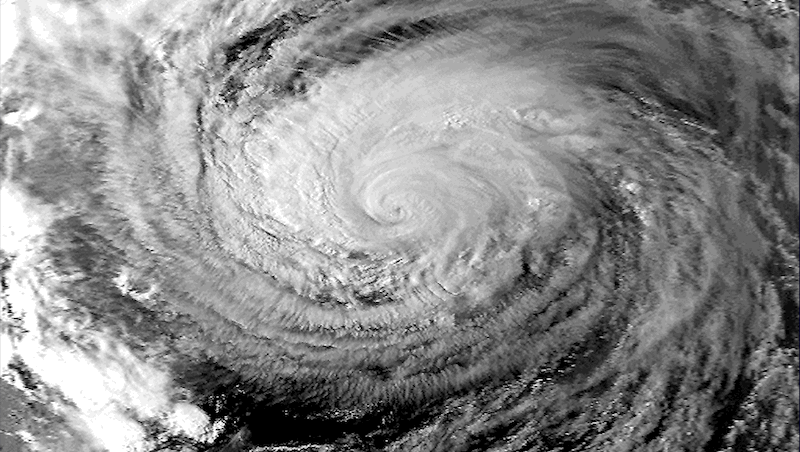Typhoon Tip: Earth's largest, most intense storm ever recorded

Hurricane Irma’s presence has been felt not only in Florida, but across the Caribbean islands.
On the tiny island of Barbuda, 95 per cent of the structures were destroyed by Irma. Antigua and Barbuda Prime Minster Gaston Browne said the storm left the island “barely habitable.”
The Category 5 storm also left a trail of destruction in St. Martin, where officials say 70 per cent of structures was destroyed on the Dutch side of the island. On Monday, the death toll caused by Irma’s wrath rose to 34 people, according to The Associated Press.
The massive hurricane that was nearly the size of Texas at one point in time has become synonymous with strong winds, heavy rain and sheer destruction. Irma ranks among some of the strongest and largest storms ever.
According to Colorado State University meteorologist Philip Klotzbach, only six Atlantic hurricanes have ever made landfall at Irma’s intensity, the most recent being Hurricane Katrina in 2005.
6 U.S. landfalling hurricanes w/ pressures < 928 mb (#Irma's current pressure): Indianola, FL Keys, Labor Day, Camille, Andrew & Katrina. pic.twitter.com/9BWzxVn4oF
— Philip Klotzbach (@philklotzbach) September 10, 2017
Are hurricanes and typhoons the same?
With all the talk about Irma, some may overlook the fact that some of the biggest storms ever recorded actually don’t take place in the Atlantic.
The Pacific Ocean gets these massive storms, too, except they’re not called hurricanes, they’re dubbed typhoons. Hurricanes and typhoons are both tropical cyclones, another term for large rotating storm systems carrying an enormous amount of power. Essentially, they are the same thing; massive storms.
There’s at least one storm in recorded history that was more massive and powerful than Irma. It was a tropical cyclone that spawned in the Pacific Ocean nearly 38 years ago.
Meet Typhoon Tip; a storm that grew to an unprecedented size in early October 1979. This Pacific storm is generally considered the largest and most intense tropical cyclone ever recorded.
The true measure of a storm’s intensity
Tip was located south of Japan and east of the Philippines in the northwest Pacific Ocean. According to the U.S. National Oceanic and Atmospheric Administration (NOAA), the storm’s circulation pattern was 2,200 kilometres in diameter. That’s roughly as big as half of the continental U.S. It’s also the length of a drive from Vancouver, B.C., to Tijuana, Mexico, or from New York City to Dallas, Texas.
Tip was colossal in size, but it also contained mighty forces of wind. The storm took advantage of warm water conditions to reach supertyphoon strength (241 km/h or greater) over the Pacific and maintained that intensity for 54 hours. It’s maximum recorded wind speed was 306 km/h.
In comparison, Irma’s peak sustained wind speed was 295 km/h, which it held for 33 hours. It’s the first storm in recorded history to hold that intensity in the Atlantic, making it the strongest Category 5 storm ever documented in that ocean.
Since the Pacific is larger than the Atlantic, there’s more warm water for storms to feed on as fuel as they grow to colossal sizes.
Low pressure is the true measure of a storm’s intensity. The storm system draws in a cycle of warm water as cold air sinks, repeating the process over and over as the storm grows in strength. The lower the atmospheric pressure, the stronger and more intense the system is.
That’s where Tip really stands out. The measured central pressure of the cyclone was 870 millibars, according to the NOAA. This is what makes it the most intense storm ever measured on Earth. Hurricane Wilma measured in at 882 mb in 2005 while in the same year, Hurricane Katrina was 902 mb. Hurricane Irma reached 915 mb, which still set a record for an Atlantic storm located outside of the western Caribbean and the Gulf of Mexico.
Other storms had stronger peak winds
There are other metrics to measure tropical cyclones. Peak wind speed at sea is another way to measure a storm. Hurricane Patricia in 2015 and Typhoon Nancy in 1961 both had stronger peak winds than Irma or Tip at 346 km/h.
But in terms of sheer size and pressure, no storm matches up to Tip.
Despite weakening before making landfall in southern Japan on Oct. 19, 1979, Tip killed nearly dozens of people and injured hundreds more. The typhoon was so powerful that its winds knocked over a gasoline storage tank, which led to a deadly fire at a U.S. Marine Corps camp at Japan’s Mount Fuji.
Fortunately, the maximum intensity of Tip occurred while the storm was in the middle of the ocean, far from any inhabited areas. The same was the case for Irma.
The circumstances of each and every tropical storm are unique to their own system, which means intensity doesn’t always result in destruction.
Some day, the perfect circumstances may exist to create a storm never seen before in modern history. But until then, Typhoon Tip is considered the biggest and most ferocious storm ever recorded.


